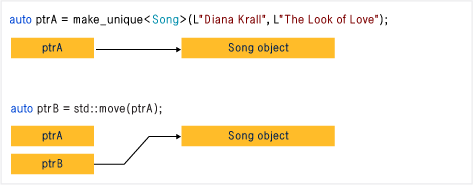STL 一共给我们提供了四种智能指针:auto_ptr、unique_ptr、shared_ptr 和 weak_ptr,auto_ptr 是 C++98 提供的解决方案,C+11 已将其摒弃,并提出了 unique_ptr 作为 auto_ptr 替代方案。虽然 auto_ptr 已被摒弃,但在实际项目中仍可使用,但建议使用较新的 unique_ptr,因为 unique_ptr 比 auto_ptr 更加安全,后文会详细叙述。shared_ptr 和 weak_ptr 则是 C+11 从准标准库 Boost 中引入的两种智能指针。此外,Boost 库还提出了 boost::scoped_ptr、boost::scoped_array、boost::intrusive_ptr 等智能指针,虽然尚未得到 C++ 标准采纳,但是在开发实践中可以使用。
auto_ptr
auto_ptr 同样是 STL 智能指针家族的成员之一,由 C++98 引入,定义在头文件
auto_ptr 从 C++98 使用至今,从 C++11 开始,引入unique_ptr 来替代 auto_ptr。
先来看下面的赋值语句:
auto_ptr<string> ps (new string ("I reigned lonely as a cloud.”);
auto_ptr<string> vocation;
vocaticn = ps;
如果 ps 和 vocation 是常规指针,则两个指针将指向同一个 string 对象。这是不能接受的,因为程序将试图删除同一个对象两次,一次是 ps 过期时,另一次是 vocation 过期时。
要避免这种问题,方法有多种:
1、定义陚值运算符,使之执行深复制。这样两个指针将指向不同的对象,其中的一个对象是另一个对象的副本,缺点是浪费空间,所以智能指针都未采用此方案。
2、建立所有权(ownership)概念。对于特定的对象,只能有一个智能指针可拥有,这样只有拥有对象的智能指针的析构函数会删除该对象。然后让赋值操作转让所有权。这就是用于 auto_ptr 和 unique_ptr 的策略,但 unique_ptr 的策略更严格。
3、创建智能更高的指针,跟踪引用特定对象的智能指针数。这称为引用计数。例如,赋值时,计数将加 1,而指针过期时,计数将减 1,。当减为 0 时才调用 delete。这是 shared_ptr 采用的策略。
当然,同样的策略也适用于复制构造函数,即auto_ptr
下面举个例子来说明。请看如下代码:
#include <iostream>
#include <string>
#include <memory>
using namespace std;
int main()
{
auto_ptr<string> films[5] ={
auto_ptr<string> (new string("Fowl Balls")),
auto_ptr<string> (new string("Duck Walks")),
auto_ptr<string> (new string("Chicken Runs")),
auto_ptr<string> (new string("Turkey Errors")),
auto_ptr<string> (new string("Goose Eggs"))
};
auto_ptr<string> pwin;
pwin = films[2]; // films[2] loses ownership. 将所有权从films[2]转让给pwin,此时films[2]不再引用该字符串从而变成空指针
cout << "The nominees for best avian baseballl film are
";
for(int i = 0; i < 5; ++i)
{
cout << *films[i] << endl;
}
cout << "The winner is " << *pwin << endl;
return 0;
}
运行下发现程序崩溃了,原因在上面注释已经说的很清楚,films[2] 已经是空指针了,下面输出访问空指针当然会崩溃了。但这里如果把 auto_ptr 换成 shared_ptr 后,程序就不会崩溃,原因如下:
使用 shared_ptr 时运行正常,因为 shared_ptr 采用引用计数,pwin 和films[2] 都指向同一块内存,在释放空间时因为事先要判断引用计数值的大小因此不会出现多次删除一个对象的错误。
使用 unique_ptr 时编译出错,与 auto_ptr 一样,unique_ptr 也采用所有权模型,但在使用 unique_ptr 时,程序不会等到运行阶段崩溃,而在编译期因下述代码行出现错误:
unique_ptr<string> pwin;
pwin = films[2]; //films[2] loses ownership
指导你发现潜在的内存错误。这就是为何要摒弃 auto_ptr 的原因,一句话总结就是:避免因潜在的内存问题导致程序崩溃。
从上面可见,unique_ptr 比 auto_ptr 更加安全,因为 auto_ptr 有拷贝语义,拷贝后原对象变得无效,再次访问原对象时会导致程序崩溃;unique_ptr 则禁止了拷贝语义,但提供了移动语义,即可以使用std::move() 进行控制权限的转移,如下代码所示:
unique_ptr<string> upt(new string("lvlv"));
unique_ptr<string> upt1(upt); //编译出错,已禁止拷贝
unique_ptr<string> upt1=upt; //编译出错,已禁止拷贝
unique_ptr<string> upt1=std::move(upt); //控制权限转移
auto_ptr<string> apt(new string("lvlv"));
auto_ptr<string> apt1(apt); //编译通过
auto_ptr<string> apt1=apt; //编译通过
这里要注意,在使用std::move将unique_ptr的控制权限转移后,不能够再通过unique_ptr来访问和控制资源了,否则同样会出现程序崩溃。我们可以在使用unique_ptr访问资源前,使用成员函数get()进行判空操作。
unique_ptr<string> upt1=std::move(upt); //控制权限转移
if(upt.get()!=nullptr) //判空操作更安全
{
//do something
}
2.unique_ptr
unique_ptr 由 C++11 引入,旨在替代不安全的 auto_ptr。unique_ptr 是一种定义在头文件<memory>中的智能指针。它持有对对象的独有权——两个unique_ptr不能指向一个对象,即 unique_ptr 不共享它所管理的对象。它无法复制到其他 unique_ptr,无法通过值传递到函数,也无法用于需要副本的任何标准模板库 (STL)算法。只能移动 unique_ptr,即对资源管理权限可以实现转移。这意味着,内存资源所有权可以转移到另一个 unique_ptr,并且原始 unique_ptr 不再拥有此资源。实际使用中,建议将对象限制为由一个所有者所有,因为多个所有权会使程序逻辑变得复杂。因此,当需要智能指针用于存 C++ 对象时,可使用 unique_ptr,构造 unique_ptr 时,可使用 make_unique Helper 函数。
下图演示了两个 unique_ptr 实例之间的所有权转换。

unique_ptr与原始指针一样有效,并可用于 STL 容器。将 unique_ptr 实例添加到 STL 容器很有效,因为通过 unique_ptr 的移动构造函数,不再需要进行复制操作。unique_ptr指针与其所指对象的关系:在智能指针生命周期内,可以改变智能指针所指对象,如创建智能指针时通过构造函数指定、通过reset方法重新指定、通过release方法释放所有权、通过移动语义转移所有权,unique_ptr还可能没有对象,这种情况被称为empty。
unique_ptr的基本操作有:
//智能指针的创建
unique_ptr<int> u_i; //创建空智能指针
u_i.reset(new int(3)); //"绑定”动态对象
unique_ptr<int> u_i2(new int(4));//创建时指定动态对象
unique_ptr<T,D> u(d); //创建空unique_ptr,执行类型为T的对象,用类型为D的对象d来替代默认的删除器delete
//所有权的变化
int *p_i = u_i2.release(); //释放所有权
unique_ptr<string> u_s(new string("abc"));
unique_ptr<string> u_s2 = std::move(u_s); //所有权转移(通过移动语义),u_s所有权转移后,变成“空指针”
u_s2.reset(u_s.release());//所有权转移
u_s2=nullptr;//显式销毁所指对象,同时智能指针变为空指针。与u_s2.reset()等价
unique_ptr不仅安全,而且灵活
如果unique_ptr 是个临时右值,编译器允许拷贝语义。参考如下代码:
unique_ptr<string> demo(const char * s){
unique_ptr<string> temp (new string (s));
return temp;
}
//假设编写了如下代码:
unique_ptr<string> ps;
ps = demo('Uniquely special");
demo()返回一个临时unique_ptr,然后ps接管了原本归返回的unique_ptr所有的对象,而返回时临时的 unique_ptr 被销毁,也就是说没有机会使用 unique_ptr 来访问无效的数据,换句话来说,这种赋值是不会出现任何问题的,即没有理由禁止这种赋值。实际上,编译器确实允许这种赋值。相对于auto_ptr任何情况下都允许拷贝语义,这正是unique_ptr更加灵活聪明的地方。